
Monetary Policy Report submitted to the Congress on February 11, 2004, pursuant to section 2B of the Federal Reserve Act
Section 2
ECONOMIC AND FINANCIAL DEVELOPMENTS IN 2003 AND EARLY 2004
The pace of economic expansion strengthened considerably in the second half of 2003 after almost two years of uneven and, on balance, sluggish growth. In early 2003, accommodative monetary policy and stimulative fiscal policies were in place, but economic activity still seemed to be weighed down by a number of factors that had restrained the recovery earlier: Geopolitical tensions were again heightened, this time by the impending war in Iraq, businesses remained unusually cautious about the strength of the expansion, and economic activity abroad was still weak. In June the continued lackluster economic growth and a further downshift in inflation from an already low level prompted a further reduction in the federal funds rate. In addition, the tax cuts that became effective at midyear provided a significant boost to disposable income. In the succeeding months, the macroeconomic stimulus began to show through clearly in sales and production, and some of the business caution seemed to recede. Real GDP increased at an annual rate of 6 percent, on average, in the third and fourth quarters of last year. In contrast, between late 2001 and mid-2003, real GDP had risen at an annual rate of only 2-1/2 percent.
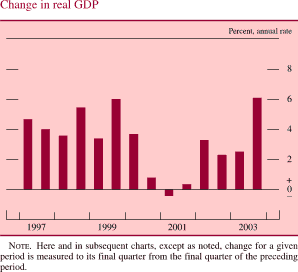
During the period of recession and subpar economic expansion, considerable slack developed in labor and product markets. The firming of economic activity in the second half of last year produced modest increases in rates of resource utilization. Sustained efforts by businesses to control costs led to further rapid gains in productivity. As a result, unit labor costs declined, and core rates of inflation continued to slow in 2003; excluding food and energy, the PCE chain-type price index increased just 0.9 percent last year. Measures of overall inflation, which were boosted by movements in food and energy prices, were higher than those for core inflation.
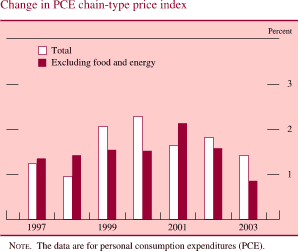
Domestic financial market conditions appeared to become increasingly supportive of economic growth last year. The economic expansion lowered investors’ perception of, and perhaps aversion to, risk, and continued disinflation was interpreted as a sign that monetary policy would remain on hold, even as the economy picked up steam. Although yields on Treasury coupon securities rose modestly on balance over the year, risk spreads on corporate debt narrowed to the point that yields on corporate issues declined. The low-interest-rate environment spurred considerable corporate bond issuance and generated a massive wave of mortgage refinancing activity by households. Equity markets began to rally when the uncertainty over the timing of military intervention in Iraq was resolved. The climb in stock prices continued for the rest of the year, driven by improving corporate earnings reports and growing optimism about the prospects for the economy. At the same time, with economic conditions abroad improving and with concerns about the financing burden of the U.S. current account deficit gaining increased attention in financial markets, the dollar fell appreciably on a trade-weighted basis.
The Household Sector
Consumer Spending
Early in 2003, consumer spending was still rising at about the same moderate pace as in 2001 and 2002. In the late spring and in the summer, however, households stepped up their spending sharply. As a result, in the second half of last year, real personal consumption expenditures rose at an annual rate of 4-3/4 percent after having increased at a rate of just under 3 percent in the first half. Although wage and salary earnings rose slowly during most of the year, the midyear reductions in tax rates and the advance of rebates to households eligible for child tax credits provided a substantial boost to after-tax income. In 2003, real disposable personal income increased 3-1/4 percent, after having risen 3-1/2 percent in 2002. Low interest rates provided additional impetus to household spending by reducing borrowing costs for new purchases of houses and durable goods; they also indirectly stimulated spending by facilitating an enormous amount of mortgage refinancing.
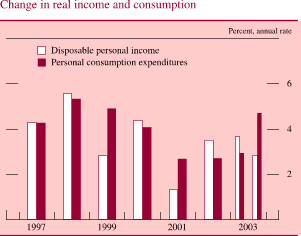
The personal saving rate has fluctuated within a fairly narrow range around 2 percent over the past three years. Although households continued to see the value of their homes appreciate over this period, they also were adjusting to the substantial drop in equity wealth that occurred after the peak in the stock market in 2000. By itself, a fall in the ratio of household wealth to income of the magnitude that households experienced between 2000 and 2002 might have triggered a noticeable increase in the personal saving rate. However, in this case, the tendency for households to save more as their wealth declines appears to have been tempered in part by their willingness to take advantage of the attractive pricing and financing environment for consumer goods.
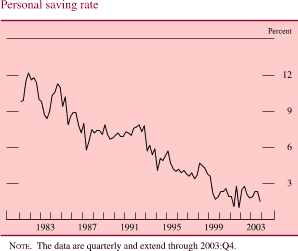
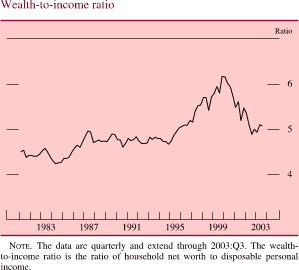
Real consumer expenditures for durable goods surged more than 11 percent in 2003. Sales of new motor vehicles remained brisk as many consumers responded to the low financing rates and various incentive deals that manufacturers offered throughout the year. Falling prices also made electronic equipment attractive to consumers, and spending on home furnishings likely received a boost from the strength of home sales. Altogether, real outlays for furniture and household equipment jumped 13-1/2 percent in 2003.
In contrast, real consumer expenditures on nondurable goods and on services continued to rise at a moderate pace, on balance, last year. Outlays for food and apparel increased a bit faster than in 2002, and the steady uptrend in spending for medical services was well maintained. However, consumers responded to the higher cost of energy by cutting back their real spending on gasoline, fuel oil, and natural gas and electricity services.
Consumer confidence was shaken temporarily early in 2003 by concerns about the consequences of a war in Iraq, but it snapped back in the spring. Toward year-end, sentiment appeared to brighten more as households saw their current financial conditions improve and gained confidence that business conditions would be better during the year ahead. Those positive views became more widely held in January, and the index of consumer sentiment prepared by the Michigan Survey Research Center (SRC) reached its highest level in three years.
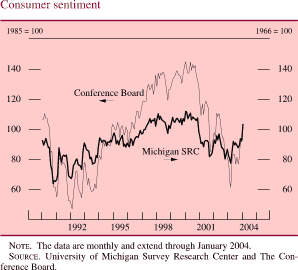
Residential Investment
Housing activity was robust for a second consecutive year in 2003. After having risen 7 percent in 2002, real expenditures on residential construction jumped more than 10 percent in 2003. These gains were fueled importantly by the lowest levels of mortgage interest rates in more than forty years, which, according to the Michigan SRC's survey of consumer sentiment, buoyed consumer attitudes toward homebuying throughout the year. The average rate on thirty-year fixed-rate mortgages dropped sharply during the first half of 2003 and reached a low of 5-1/4 percent in June. Although the thirty-year rate subsequently firmed somewhat, it remained below 6 percent, on average, in the second half of last year.
Construction of new single-family homes accelerated during 2003, and for the year as a whole, starts averaged 1.5 million units, an increase of 10 percent compared with the level in 2002. Sales of both new and existing single-family homes also picked up sharply further last year. The brisk demand for homes was accompanied by rapid increases in the average price paid for them. The average price paid for new homes rose 10 percent over the four quarters of 2003, and the average price of existing homes was up 7-3/4 percent over the same period. However, house price inflation was lower after adjusting for shifts in the composition of transactions toward more expensive homes. The constant-quality price index for new homes, which eliminates the influence of changes in their amenities and their geographic distribution, increased 4-3/4 percent over the four quarters of 2003--down from an increase of 6 percent during 2002. The year-over-year increase in Freddie Mac’s index of the prices paid in repeat sales of existing homes stood at 5-1/2 percent as of the third quarter of 2003, compared with a rise of 7-1/4 percent as of the third quarter of 2002.
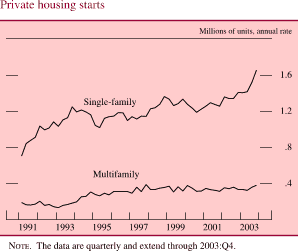
Starts in the multifamily sector totaled 350,000 units in 2003, a pace little changed from that of the past several years. Vacancy rates for these units rose and rents fell during the year, but falling mortgage rates apparently helped to maintain building activity.
Household Finance
Household debt increased 10-3/4 percent last year, in large part because of the surge in mortgage borrowing induced by record-low mortgage interest rates. Refinancing activity was torrid in the first half of the year, as mortgage rates declined. Some of the equity that households extracted from their homes during refinancings was apparently used to fund home improvements and to pay down higher-interest consumer debt. When mortgage rates rebounded in the second half of the year, mortgage borrowing slowed from the extremely rapid clip of the first half, but it remained brisk through year-end. Consumer credit increased at a pace of 5-1/4 percent in 2003, a little faster than a year earlier, as revolving credit picked up somewhat from the slow rise recorded in 2002. Despite the pickup in household borrowing, low interest rates kept the household debt-service and financial-obligation ratios--which gauge pre-committed expenditures relative to disposable income--at roughly the levels posted in 2002. Most measures of delinquencies on consumer loans and home mortgages changed little on net last year, and household bankruptcies held roughly steady near their elevated level in 2002.
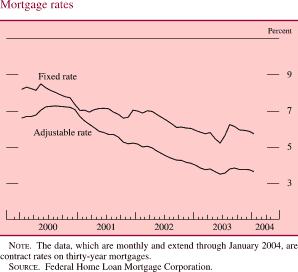
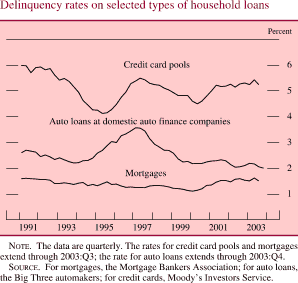
Even with the rapid expansion in debt, net worth of the household sector increased as the value of household assets rose noticeably. Stock prices were boosted by the rise in corporate earnings and the ebbing of uncertainty about future economic growth. Households directed substantial flows into stock mutual funds in the third and fourth quarters despite highly publicized scandals in the mutual fund industry. Although the companies directly implicated in wrongdoing experienced heavy outflows from their funds, most of these withdrawals apparently were transferred to other mutual funds with little effect on the industry as a whole. A considerable rise in real estate wealth further augmented household assets. Although prices of existing homes climbed more slowly than they had in the previous year, the rate of increase remained sizable. Overall, the advance in the value of household assets outstripped the accumulation of household debt by enough to boost the ratio of net worth to disposable income over the year.
The Business Sector
Fixed Investment
Business spending on equipment and software was still sluggish at the beginning of 2003. However, it accelerated noticeably over the course of the year as profits and cash flow rebounded and as businesses gained confidence in the strength of the economic expansion and in the prospective payoffs from new investment. At the same time, business financing conditions were very favorable: Interest rates remained low, equity values rallied, and the enhanced partial-expensing tax provision gave a special incentive for the purchase of new equipment and software. After having changed little in the first quarter of the year, real outlays for equipment and software increased at an annual rate of 11-3/4 percent over the remaining three quarters of the year.
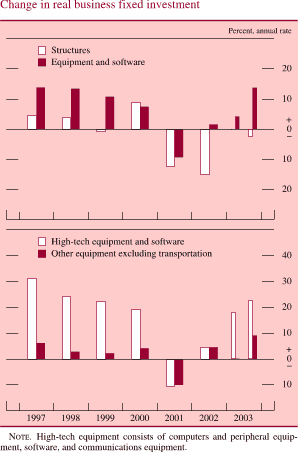
Outlays for high-technology items--computers and peripherals, software, and communications equipment--which had risen a moderate 4-1/2 percent in 2002, posted a significantly more robust increase of more than 20 percent in 2003. That gain contributed importantly to the pickup in overall business outlays for equipment and software and pushed the level of real high-tech outlays above the previous peak at the end of 2000. The increase in spending last year on computing equipment marked the sharpest gain since 1998, and investment in communications equipment, which had continued to contract in 2002 after having plummeted a year earlier, turned up markedly.
In contrast, the recovery in spending on non-high-tech equipment was, on balance, more muted, in part because outlays for transportation equipment continued to fall. The prolonged slump in business purchases of new aircraft continued in 2003 as domestic air carriers grappled with overcapacity and high fixed costs. By the fourth quarter, real outlays for aircraft had dropped to their lowest level in ten years. In the market for heavy (class 8) trucks, sales were quite slow in early 2003 when businesses were concerned about the performance of models with engines that met new emission standards. But as potential buyers overcame those concerns, sales recovered. By the fourth quarter of 2003, sales of medium and heavy trucks had moved noticeably above the slow pace of 2001 and 2002. Apart from outlays for transportation equipment, investment in other types of non-high-tech equipment was, on balance, little changed during the first half of the year. Demand was strong for medical equipment, instruments, and mining and oilfield machinery, but sales of industrial equipment and farm and construction machinery were sluggish. In the second half of the year, however, the firming in business spending for non-high-tech items became more broadly based.
The steep downturn in nonresidential construction that began in 2001 moderated noticeably in 2003, although market conditions generally remained weak. After having contracted at an average annual rate of 13-1/2 percent during 2001 and 2002, real expenditures for nonresidential construction slipped just 1-1/4 percent, on balance, during 2003. Spending on office buildings and manufacturing structures, which had dropped sharply over the preceding two years, fell again in 2003. The high office vacancy rates in many areas and low rates of factory utilization implied little need for new construction in these sectors even as economic activity firmed. Investment in communications infrastructure, where a glut of long-haul fiber-optic cable had developed earlier, also continued to shrink. In contrast, outlays for retail facilities, such as department stores and shopping malls, turned up last year, and the retrenchment in construction of new hotels and motels ended. In addition, investment in drilling and mining structures, which is strongly influenced by the price levels for crude oil and natural gas, increased noticeably in 2003.
Inventory Investment
During 2002, businesses appeared to have addressed most of the inventory imbalances that had developed a year earlier. But the moderate pace of final demand during the first half of 2003 apparently restrained firms from embarking on a new round of inventory accumulation. Even though final sales picked up in the second half of the year, the restraint seemed to recede only gradually. Over the first three quarters of 2003, nonfarm businesses trimmed their inventories at an average annual rate of $2-3/4 billion in constant-dollar terms, and the preliminary estimate for the final quarter of the year indicated only modest restocking. As a result, most firms appear to have ended the year with their inventories quite lean relative to sales, even after taking into account the downward trend in inventory-sales ratios that has accompanied the ongoing shift to improved inventory management. Motor vehicle dealers were an exception; their days' supply of new vehicles moved higher on average for a second year in a row.
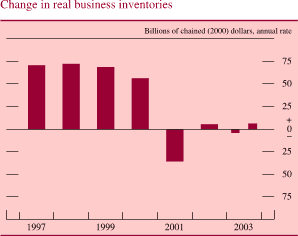
Corporate Profits and Business Finance
Higher profits allowed many firms to finance capital spending with internal funds, and business debt rose only slightly faster than the depressed rate in 2002. Moreover, a paucity of cash-financed merger and acquisition activity further limited the need to issue debt. Gross equity issuance was extremely weak in the first half of the year but perked up in the latter half in response to the rally in equity prices. Nevertheless, for the year as a whole, firms extinguished more equity than they issued.
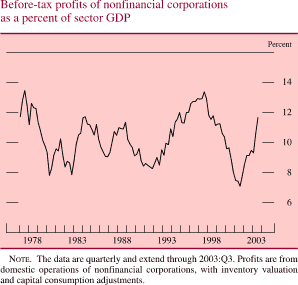
The pace of gross corporate bond issuance was moderate at the start of the year but shot up in late spring as firms took advantage of low bond yields to pay down short-term debt, to refund existing long-term debt, and to raise cash in anticipation of future spending. Bond issuance by investment-grade firms slowed after midyear as firms accumulated a substantial cushion of liquid assets and as interest rates on higher-quality debt backed up. However, issuance by speculative-grade firms continued apace, with the yields on their debt continuing to decline dramatically presumably because of investors’ increased optimism about the economic outlook and greater willingness to take on risk. The sum of bank loans and commercial paper outstanding, which represent the major components of short-term business debt, contracted throughout the year. In large part, this decline reflected ongoing substitution toward bond financing, but it also was driven by the softness of fixed investment early in the year and the liquidation of inventories over much of the year.
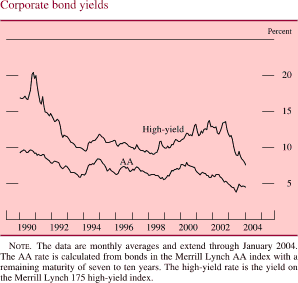
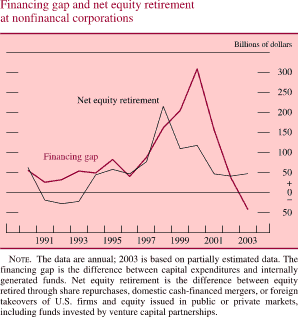
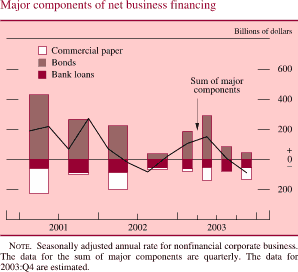
Respondents to the Senior Loan Officer Opinion Survey on Bank Lending Practices noted that terms and standards on business loans were tightened during the first half of the year but that both had been eased considerably by year-end. They also reported that demand for business loans was quite weak for much of the year. However, despite the fact that outstanding levels of business loans continued to decline, survey responses in the last quarter of the year indicated that demand for loans had begun to stabilize. Many banks cited customers’ increased investment and inventory spending as factors helping to generate the increase in loan demand toward the end of the year. The apparent divergence between survey responses and data on actual loan volumes may suggest that demand for lines of credit has increased but that these lines have not yet been drawn. In other short-term financing developments, nonfinancial firms that issued commercial paper in 2003 found a very receptive market, in large part because of the scarcity of outstanding issues. Many of the riskiest borrowers had exited the market in 2002, and remaining issuers improved their attractiveness to investors by continuing to restructure their balance sheets.
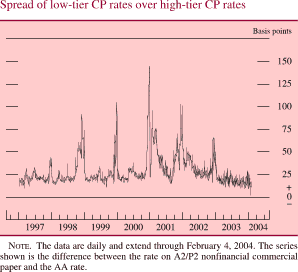
Gross equity issuance rose over the course of 2003 as the economic outlook strengthened and stock prices moved higher. The market for initial public offerings continued to languish in the first half of the year but showed signs of life by the end of the summer. The volume of seasoned offerings also picked up in the second half of the year. On the other side of the ledger, merger and acquisition activity again extinguished shares in 2003, although only at a subdued pace. In addition, firms continued to retire a considerable volume of equity through share repurchases. For the year as a whole, net equity issuance was negative.
Corporate credit quality improved, on balance, over the year. Notably, the default rate on corporate bonds declined sharply, delinquency rates on commercial and industrial (C&I) loans at commercial banks turned down, and the pace of bond-rating downgrades slowed considerably. Low interest rates and the resulting restructuring of debt obligations toward longer terms also importantly contributed to improved business credit quality. Bank loan officers noted that the aggressive tightening of lending standards in earlier years was an important factor accounting for the lower delinquency and charge-off rates in recent quarters.
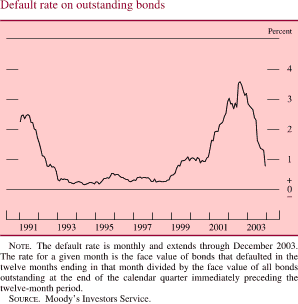
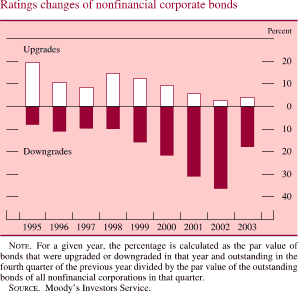
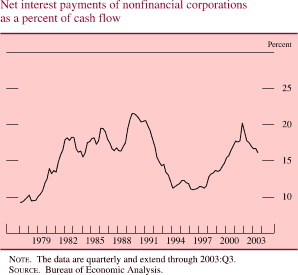
Commercial mortgage debt increased noticeably during most of 2003 despite persistently high vacancy rates, falling rents, and sluggish growth in construction expenditures. Low interest rates on this type of collateralized debt may have induced some corporate borrowers to tap the market to pay down more-costly unsecured debt. Delinquency rates on commercial mortgages generally remained low throughout 2003, and risk spreads were relatively narrow. Loan performance has held up well because of low carrying costs for property owners and because the outstanding loans generally had been structured to include a sizable equity contribution, which makes default less attractive to borrowers.
The Government Sector
Federal Government
The federal budget deficit continued to widen in fiscal year 2003 as a result of the slow increase in nominal incomes, outlays associated with the war in Iraq, and legislative actions that reduced taxes and boosted spending. The deficit in the unified budget totaled $375 billion, up substantially from the deficit of $158 billion recorded in fiscal 2002. The Congressional Budget Office is projecting that the unified federal deficit will increase further in fiscal 2004, to more than $475 billion.
Federal receipts have fallen in each of the past three years; the drop of nearly 4 percent in fiscal 2003 brought the ratio of receipts to GDP to 16-1/2 percent, 2 percentage points below the average for the past thirty years. About half of the decrease in receipts last year was a consequence of legislation that shifted due dates for corporate payments between fiscal years. In addition, personal income tax collections dropped sharply because of the slow rise in nominal wages and salaries, diminished capital gains realizations in 2002, and the tax cuts enacted under the Jobs and Growth Tax Relief Reconciliation Act of 2003. The act advanced refund checks to households eligible for the 2003 increment to the child tax credit and resulted in lower withholding schedules for individual taxpayers. The act also expanded the partial-expensing incentive for businesses, but because corporate profits accelerated sharply last year, corporate tax receipts rose appreciably after adjusting for the shifts in the timing of payments.
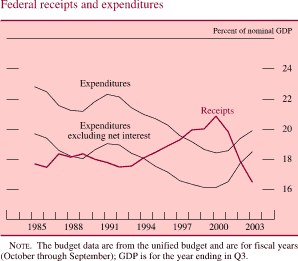
At the same time, federal outlays other than for interest expense rose rapidly for the second consecutive year in fiscal 2003; these outlays increased about 9 percent after having risen 11 percent in fiscal 2002. Spurred by operations in Iraq, defense spending soared again, and outlays for homeland security rose further. Spending for income support, such as unemployment insurance, food stamps, and child credits under the earned income tax credit program, also posted a sizable increase. The ongoing rise in the cost and utilization of medical services continued to push up spending for Medicare and Medicaid. Overall, real federal consumption and investment (the measure of federal spending that is included in real GDP) increased 6 percent over the four quarters of 2003, after having risen 10 percent a year earlier.
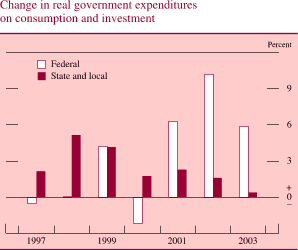
The federal government had contributed increasingly to national saving in the late 1990s and 2000 as budget deficits gave way to accumulating surpluses. However, with the swing back to large deficits in recent years, the federal government has again become a drain on national saving. Using the accounting practices followed in the national income and product accounts (NIPA), gross federal saving as a percent of GDP dropped sharply in late 2001 and has trended down since then; the drop contributed to a decline in overall gross national saving as a percent of GDP from 18 percent in calendar year 2000 to 13 percent, on average, in the first three quarters of 2003. Federal saving net of estimated depreciation fell from its recent peak of 2-1/2 percent of GDP in 2000 to negative 4 percent of GDP, on average, in the first three quarters of 2003. As a result, despite a noticeable pickup in saving from domestic nonfederal sources, overall net national saving, which is an important determinant of private capital formation, fell to less than 1-1/2 percent of GDP, on average, in the first three quarters of 2003, compared with a recent high of 6-1/2 percent of GDP in 1998.
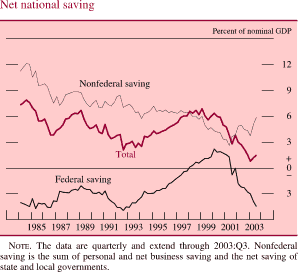
Federal Borrowing
The Treasury ramped up borrowing in 2003 in response to the sharply widening federal budget deficit, and federal debt held by the public as a percent of nominal GDP increased for a second year in a row after having trended down over the previous decade. As had been the case in 2002, the Treasury was forced to resort temporarily to accounting devices in the spring of 2003 when the statutory debt ceiling became a constraint, but debt markets were not disrupted noticeably. In May, the Congress raised the debt ceiling from $6.4 trillion to $7.4 trillion. With large deficits expected to persist, the Treasury made a number of adjustments to its regular borrowing program, including reintroducing the three-year note, increasing to monthly the frequency of five-year note auctions, reopening the ten-year note in the month following each new quarterly offering, and adding another auction of ten-year inflation-indexed debt. As a result of these changes, the average maturity of outstanding Treasury debt, which had reached its lowest level in decades, began to rise in the latter half of 2003.
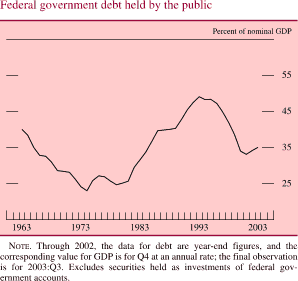
State and Local Governments
State and local governments faced another difficult year in 2003. Tax receipts on income and sales continued to be restrained by the subdued performance of the economy. Despite further efforts to rein in spending, the sector’s aggregate net saving, as measured in the NIPA, reached a low of negative $40 billion (at an annual rate), or negative 0.4 percent of GDP, in the first quarter of the year. Most of these jurisdictions are subject to balanced-budget requirements and other rules that require them to respond to fiscal imbalances. Thus, in addition to reducing operating expenses, governments drew on reserves, issued bonds, sold assets, and made various one-time adjustments in the timing of payments to balance their books. In recent years, many have also increased taxes and fees, thereby reversing the trend toward lower taxes that prevailed during the late 1990s.
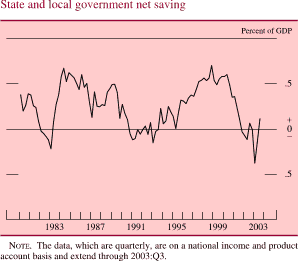
Recent indications are that the fiscal stress in this sector is beginning to ease. The improvement reflects a noticeable upturn in tax collections in recent quarters while restraint on operating expenditures largely remains in place. On a NIPA basis, real spending on compensation and on goods and services purchased by state and local governments was little changed in the second half of 2003, as it was over the preceding year. However, investment in infrastructure, most of which is funded in the capital markets, accelerated in the second half of 2003. As of the third quarter of 2003, state and local net saving had moved back into positive territory.
State and Local Government Borrowing
Gross issuance of debt by state and local governments was quite robust last year. Weak tax receipts from a sluggish economy, significant demands for infrastructure spending, and low interest rates all contributed to the heavy pace of borrowing. Borrowing was strongest in the second quarter of the year, as governments took advantage of the extraordinarily low longer-term rates to fund capital expenditures and to advance refund existing higher-cost debt. Because of the financial stresses facing these governments, the credit ratings of several states, most notably California, were lowered last year. Although bond downgrades outnumbered upgrades for the sector as a whole, the imbalance between the two was smaller than it was in 2002.
The External Sector
Over the first three quarters of 2003, the U.S. current account deficit widened relative to the comparable period in 2002, a move largely reflecting developments in the deficit on trade in goods and services. Net investment income rose over the same period, as receipts from abroad increased and payments to foreign investors in the United States declined.
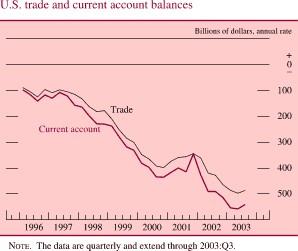
International Trade
The trade deficit widened considerably in the first half of 2003 but narrowed slightly in the third quarter, as the value of exports rebounded in response to strengthening foreign economic activity and the depreciation of the dollar. Available trade data through November suggest that the trade deficit narrowed further in the fourth quarter, as an additional strong increase in exports outweighed an increase in imports.
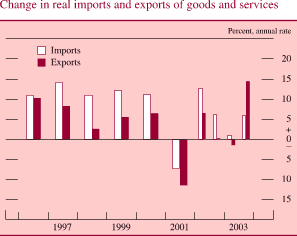
Real exports of goods and services increased about 6 percent in 2003. Exports of services rose about 5 percent. They were held down early in the year by a drop in receipts from foreign travelers, owing to the effects of the SARS (severe acute respiratory syndrome) epidemic and the war in Iraq; services exports rebounded strongly later in the year as those concerns receded. Exports of goods rose about 6-3/4 percent over the course of the year--considerably faster than in 2002. Exports increased in all major end-use categories of trade, with particularly strong gains in capital goods and consumer goods. Reflecting the global recovery in the high-tech sector, exports of computers and semiconductors picked up markedly in 2003, particularly in the second half. By geographic area, exports of goods increased to Western Europe, Canada, and, particularly, to developing countries in East Asia--a region where economic activity expanded at a rapid pace last year. Prices of exported goods rose in 2003, with prices of agricultural exports recording particularly large increases. In response to poor crops and strong demand, prices for cotton and soybeans increased sharply. For beef, disruptions in supply led to notably higher prices through much of 2003. Beef prices, however, fell back in late December after a case of mad cow disease was discovered in the state of Washington and most countries imposed bans on beef imports from the United States.
Real imports of goods and services rose about 3-1/2 percent in 2003. Imports of services fell in the first half of the year but bounced back in the second half, as concerns about the SARS epidemic and the war in Iraq came and went; for the year as a whole, real imports of services were about unchanged from the previous year. Real imports of goods expanded about 4 percent in response to the strengthening of U.S. demand, but the pattern was choppy, with large gains in the second and fourth quarters partially offset by declines in the first and third. Despite a surge in the second quarter, the volume of oil imports increased modestly, on balance, over the course of the year. Real non-oil imports were up about 4-1/2 percent, with the largest increases in capital goods and consumer goods. Imports of computers posted solid gains, whereas imports of semiconductors were flat.
Despite a substantial decline in the value of the dollar, the prices of imported non-oil goods rose only moderately in 2003. By category, the prices of consumer goods were unchanged last year, and prices of capital goods excluding aircraft, computers, and semiconductors increased only a little more than 1 percent. Price increases were larger for industrial supplies. The price of imported natural gas spiked in March and rose again late in the year; these fluctuations were large enough to show through to the overall price index for imported goods. At year-end, prices of industrial metals rose sharply, with the spot price of copper reaching the highest level in six and one-half years. The strength in metals and other commodity prices has been attributed, at least in part, to depreciation of the dollar and strong global demand, particularly from China.
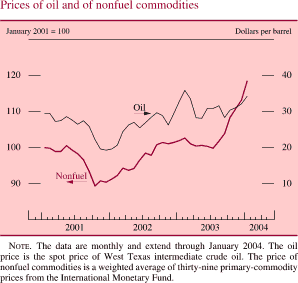
In 2003, the spot price of West Texas intermediate (WTI) crude oil averaged more than $31 per barrel--the highest annual average since the early 1980s. The spot price of oil began to rise at the end of 2002 when ethnic unrest in Nigeria and a nationwide strike in Venezuela sharply limited oil supplies from those two countries. In the first quarter of 2003, geopolitical uncertainty in the period leading up to the war in Iraq also added upward pressure on oil prices. On March 12, the spot price of WTI closed at $37.83 per barrel, the highest level since the Gulf War in 1990. When the main Iraqi oil fields had been secured and it became apparent that the risks to oil supplies had subsided, the spot price of WTI fell sharply to a low of $25.23 per barrel on April 29. However, oil prices began rising again when, because of difficult security conditions, the recovery of oil exports from Iraq was slower than expected. Prices also were boosted in September by the surprise reduction in OPEC’s production target. In the fourth quarter of 2003 and early 2004, strengthening economic activity, falling oil inventories, and the continued depreciation of the dollar contributed to a further run-up in oil prices.
The Financial Account
The financing counterpart to the current account deficit experienced a sizable shift in 2003, as net private inflows fell while foreign official inflows increased. Private foreign purchases of U.S. securities were at an annual rate of about $350 billion through November, about $50 billion lower than in the previous year. Private foreign purchases of U.S. equities continued to recede, and, although the level of bond purchases was little changed in the aggregate, foreign purchases shifted somewhat away from agency bonds and toward corporate bonds. Over the same period, purchases by private U.S. investors of foreign securities increased nearly $80 billion. Accordingly, net inflows through private securities transactions decreased markedly. In contrast, foreign official purchases of U.S. assets surged to record levels in 2003, with the accumulation of dollar reserves particularly high in China and Japan.
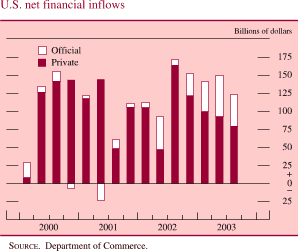
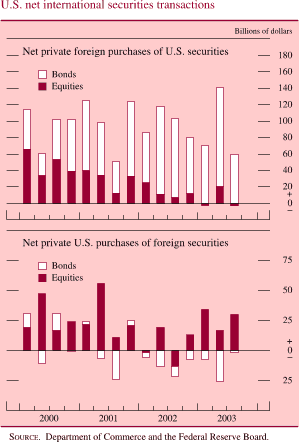
Compared with the pace in 2002, foreign direct investment in the United States increased, as merger activity picked up and corporate profits improved. U.S. direct investment abroad held relatively steady at a high level that was largely the result of continued retained earnings. On net, foreign direct investment outflows fell about $50 billion through the first three quarters of 2003.
The Labor Market
Employment and Unemployment
With economic activity still sluggish during the first half of 2003, the labor market continued to weaken. Over the first eight months of the year, private nonfarm payroll employment fell, on average, more than 35,000 per month, extending the prolonged period of cutbacks that began in early 2001. The civilian unemployment rate, which had hovered around 5-3/4 percent for much of 2002, moved up to 6-1/4 percent by June. However, by late in the summer, the labor market began to recover slowly. Declines in private payrolls gave way to moderate increases in employment; over the five months ending in January, private nonfarm establishments added, on average, about 85,000 jobs per month. By January, the unemployment rate moved back down to 5.6 percent.
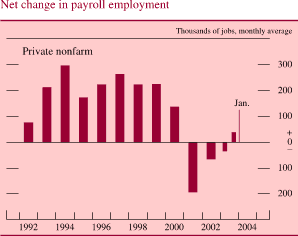
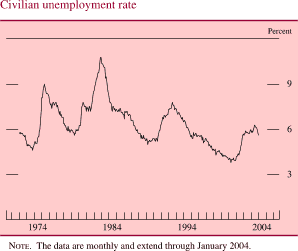
During the late summer and early fall, prospects for business sales and production brightened, and firms began to lay off fewer workers. Initial claims for unemployment insurance dropped back, and the monthly Current Population Survey (CPS) of households reported a decline in the number of workers who had lost their last job. However, for many unemployed workers, jobs continued to be difficult to find, and the number of unemployed who had been out of work for twenty-seven weeks or more remained persistently high. The labor force participation rate, which tends to be sensitive to workers’ perceptions of the strength of labor demand, drifted lower. Although the CPS indicated a somewhat greater improvement in employment than the payroll report--even after adjusting for conceptual differences between the two measures--the increase in household employment lagged the rise in the working-age population, and the ratio of employment to population fell further during 2003.
The modest upturn in private payroll employment that began in September was marked by a step-up in hiring at businesses supplying professional, business, and education services, and medical services continued to add jobs. Employment in both the construction industry and the real estate industry rose further, although the number of jobs in related financial services dropped back a bit as mortgage refinancing activity slackened. At the same time, although manufacturers were still laying off workers, the monthly declines in factory employment became smaller and less widespread than earlier. Employment stabilized in many industries that produce durable goods, such as metals, furniture, and wood products, as well as in a number of related industries that store and transport goods. In several other areas, employment remained weak. Manufacturers of nondurables, such as chemicals, paper, apparel, and textiles, continued to cut jobs. Employment in retail trade remained, on net, little changed.
Productivity and Labor Costs
Business efforts to increase efficiency and control costs led to another impressive gain in labor productivity last year. Output per hour in the nonfarm business sector surged 5-1/4 percent in 2003 after having risen a robust 4 percent in 2002 and 2-3/4 percent in 2001. What is particularly remarkable about this period is that productivity did not decelerate significantly when output declined in 2001, and it posted persistently strong gains while the recovery in aggregate demand was sluggish. Typically, the outsized increases in productivity that have occurred during cyclical recoveries have followed a period of declines or very weak increases in productivity during the recession and have been associated with rebounds in economic activity that were stronger than has been the case, until recently, in this expansion.
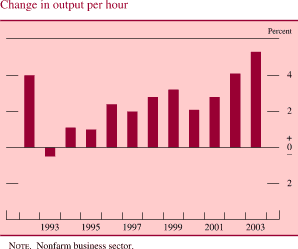
On balance, since the business cycle peak in early 2001, output per hour has risen at an average annual rate of 4 percent--noticeably above the average increase of 2-1/2 percent that prevailed between 1996 and 2000. In the earlier period, an expansion of the capital stock was an important element in boosting the efficiency of workers and their firms; that impetus to productivity has weakened in the recent period as a result of the steep cutbacks in business investment in 2001 and 2002. Instead, the recent gains appear to be grounded in organizational changes and innovations in the use of existing resources--which are referred to as multifactor productivity. The persistence of a rapid rise in multifactor productivity in recent years, along with signs of a pickup in capital spending, suggests that part of the step-up in the rate of increase of labor productivity may be sustained for some time.
In 2003, the employment cost index (ECI) for private nonfarm businesses, which is based on a survey conducted quarterly by the Bureau of Labor Statistics, rose 4 percent--about 3/4 percentage point more than the increase in 2002. Compensation per hour in the nonfarm business sector, which is based on data constructed for the NIPA, is estimated to have increased 3-1/4 percent in 2003, up from 1-1/2 percent in 2002. In recent years, the NIPA-derived series has shown much wider fluctuations in hourly compensation than the ECI, in part because it includes the value of stock option exercises, which are excluded from the ECI. The value of options exercised shot up in 2000 and then dropped over the next two years.
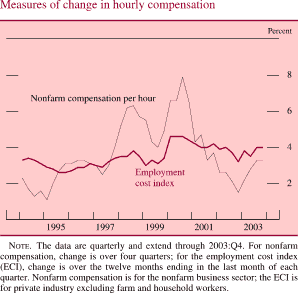
Most of the acceleration in hourly compensation in 2003 was the result of larger increases in the costs of employee benefits. The ECI for wages and salaries rose 3 percent--up slightly from the pace in 2002 but still well below the rates of increase in the preceding six years. Wage gains last year likely were restrained by persistent slack in the demand for labor as well as by the pressure on employers to control overall labor costs in the face of the rapidly rising cost of benefits. Employer costs for benefits, which had risen 4-3/4 percent in 2002, climbed another 6-1/2 percent in 2003. The cost of health insurance as measured by the ECI has been moving up at close to a double-digit rate for three consecutive years. In addition, in late 2002 and early 2003, employers needed to substantially boost their contributions to defined-benefit retirement plans to cover the declines in the market value of plan assets.
Prices
Headline consumer price inflation in 2003 was maintained by an acceleration in food prices and another sizable increase in energy prices, but core rates of inflation fell for a second year. Although the strong upturn in economic activity in the second half of last year began to reduce unemployment and to boost industrial utilization rates, considerable slack in labor and product markets continued to restrain inflation throughout the year. A further moderation in the costs of production also helped to check inflation: As a result of another rapid rise in productivity, businesses saw their unit labor costs decline in 2003 for a second consecutive year. In contrast, prices for imported goods excluding petroleum, computers, and semiconductors increased at about the same rate as prices more generally; between 1996 and 2002, these import prices fell relative to overall prices for personal consumption expenditures (PCE). The chain-type price index for PCE excluding food and energy rose just under 1 percent in 2003, about 3/4 percentage point less than in 2002. A broader measure of inflation, the chain-type price index for GDP, increased 1-1/2 percent in 2003, the same slow pace as in 2002. Both measures of inflation were roughly a percentage point lower than in 2001.
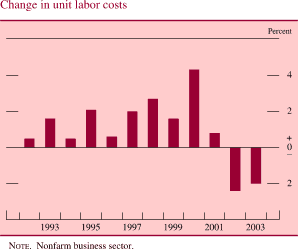
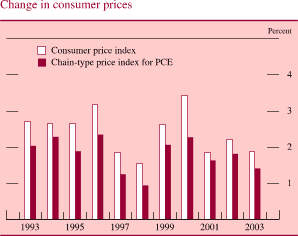
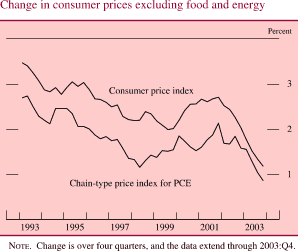
Consumer energy prices fluctuated widely over the four quarters of 2003, and the PCE index for energy was up 7-1/4 percent over the period. In the first quarter of the year, the combination of a further rise in the cost of crude oil, increased wholesale margins for gasoline, and unusually tight supplies of natural gas pushed up consumer energy prices sharply. Although the prices of petroleum-based products turned down when the price of crude oil fell back in March, a number of supply disruptions in late summer resulted in another temporary run-up in the retail price of gasoline. In the spring, the price of natural gas began to ease as supplies improved, but it remained high relative to the level in recent years. Electricity prices also moved up during 2003, in part because of the higher input costs of natural gas. In January 2004, a cold wave in the Northeast, together with the rise in the price of crude oil since early December, once again led to spikes in the prices of gasoline and natural gas.
The PCE price index for food and beverages increased 2-3/4 percent in 2003 after having risen just 1-1/4 percent a year earlier. Much of the acceleration can be traced to strong demand for farm products, but prices paid by consumers for food away from home--which depend much more heavily on the cost of labor than on prices of food products--were up 3 percent in 2003, also somewhat more than overall consumer price inflation. Poor harvests abroad, especially in Europe, contributed importantly to the heightened demand for U.S. farm products. Thus, despite a bumper crop of corn and some other grains in the United States, world stocks were tight and prices remained high. In addition, the U.S. soybean crop was crimped by late-season heat and dryness, which further tightened world supplies. Concerns about the cases of mad cow disease that were identified in herds in Japan and Canada supported strong domestic and export demand for U.S. beef for most of last year while supplies edged down. But, at year-end, when a case of mad cow disease was discovered in a domestic herd, export demand for U.S. beef plunged and drove the price of live cattle down sharply. A portion of the drop in cattle prices likely will show through to consumer prices for beef early this year.
The decline in core inflation in 2003 was broadly based. Prices of core consumer goods fell somewhat faster than a year earlier; the declines were led by larger cuts in prices of apparel, motor vehicles, electronic equipment, and a variety of other durable goods. At the same time, prices of non-energy services rose less rapidly. The deceleration in core consumer prices measured by the CPI is somewhat greater than that measured by the PCE index. In each index, the costs of housing services to tenants and owners rose less in 2003 than in 2002, but because these costs receive a larger weight in the CPI, their slowing contributed a greater amount to the CPI’s deceleration. In addition, the different measurement of the prices of medical services in the two series contributed to the smaller deceleration in non-energy services in the PCE. The medical services component of the CPI, which measures out-of-pocket expenses paid by consumers, increased 4 percent in 2003, down from 5-1/2 percent a year earlier. Alternatively, the PCE for medical services is a broader measure that uses producer price indexes (PPI) to capture the costs of services provided by hospitals and doctors; it continued to increase more slowly than the CPI for medical services last year, 3-1/4 percent, but it was up slightly from its increase of 2-1/2 percent in 2002.